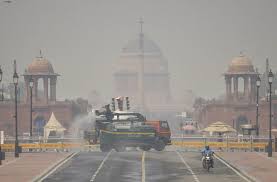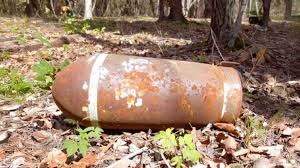Air Quality in Delhi-NCR Dips into “Severe” Zone Post-Diwali; AQI Readings Spike Nationwide
Air quality in the Delhi-NCR region has deteriorated to the “severe” zone following the Diwali celebrations, with a sharp rise in pollution levels. The Central Pollution Control Board (CPCB) and local monitoring agencies reported that the air quality index (AQI) in Delhi, Noida, Gurugram and surrounding areas crossed 450, indicating hazardous air conditions. Experts have warned residents to take immediate precautions, especially people with respiratory problems, children and the elderly.
AQI level after Diwali
According to the latest CPCB data, Delhi recorded an AQI of 492 on Friday morning, making it one of the most polluted cities in the world at present. AQI readings in Noida and Ghaziabad were recorded at 478 and 465, respectively, while the AQI in Gurugram rose to 451. This reading shows a sharp increase from pre-Diwali levels, which were around 200-250, which is classified as “moderate to poor”.
Experts attribute the sharp decline to the combined effect of Diwali crackers, crop residue burning in neighbouring states and a drop in wind speed, which has restricted the spread of pollutants. Dr. R.K. “The festive season has significantly deteriorated the air quality. Firecrackers alone contribute significantly to PM2.5 and PM10 particles, which are extremely harmful to human health,” said Agarwal, an air quality expert.
Health Impacts
The surge in AQI levels poses serious health risks. PM2.5 and PM10 particles can penetrate deep into the lungs and even enter the bloodstream, causing respiratory and cardiovascular problems. Hospitals in Delhi-NCR have already reported an increase in patients complaining of cough, breathing difficulties, and eye irritation.
Dr. Sangeeta Mehta, a pulmonologist at Safdarjung Hospital, said, “We are seeing more cases of aggravated asthma and chronic obstructive pulmonary disease (COPD) after Diwali. Even healthy individuals are experiencing headaches, throat irritation, and persistent coughing.”
Authorities have issued health advisories urging people to stay indoors, avoid outdoor exercise, wear masks if venturing outside, and use air purifiers at home. Schools in some parts of Delhi have decided to suspend outdoor activities to protect children from the polluted air.
National Scenario
The pollution spike is not limited to Delhi-NCR. Cities across northern India, including Lucknow, Patna, Jaipur, and Chandigarh, have reported AQI readings in the “Very Poor” to “Severe” range. Lucknow recorded an AQI of 410, while Jaipur’s AQI touched 430.
Satellite imagery has also indicated widespread smog coverage over northern India. Meteorologists point out that low temperatures and calm winds in the post-Diwali period exacerbate pollution levels, preventing pollutants from dispersing. Additionally, stubble burning in Punjab and Haryana continues to add particulate matter to the already toxic air mix.
Government Measures and Public Response
The Delhi government has activated emergency measures to tackle the pollution surge. Anti-smog guns have been deployed in industrial areas, and the city’s Graded Response Action Plan (GRAP) has been implemented. Measures include the restriction of construction activities, increased monitoring of industrial emissions, and urging citizens to avoid burning garbage or firecrackers.
Despite these efforts, enforcement remains challenging. CCTV footage and drone surveys indicate that many residents continue to burst firecrackers in residential areas. Environmentalists have criticized the lack of awareness and compliance among citizens.
Raghav Kapoor, an activist with the Delhi Pollution Control Committee, commented, “People celebrate festivals without realizing the long-term impact on health and the environment. Immediate policy action is necessary, but public cooperation is equally important to reduce air pollution.”
Impact on Daily Life and Economy
The severe pollution has disrupted daily life in multiple ways. Flight operations at Delhi’s Indira Gandhi International Airport have been delayed due to low visibility caused by smog. Traffic congestion has worsened as commuters struggle with dense haze, leading to slower movement on major highways and roads.
Moreover, economic implications are emerging as hospitals report higher patient loads, increasing medical expenses for households. Studies suggest that extreme air pollution can reduce labor productivity, as employees face respiratory ailments and absenteeism rises. Tourism and outdoor events are also affected, with public gatherings and cultural events witnessing lower footfall due to poor air quality.
Call for Long-Term Solutions
Experts stress that while immediate precautions are essential, long-term strategies are crucial to prevent recurring pollution crises. These include stricter enforcement of anti-stubble burning laws, promotion of cleaner fuels and public transport, increased green cover, and public awareness campaigns to curb firecracker usage.
Professor Anil Kumar from the Indian Institute of Technology, Delhi, said, “The post-Diwali pollution spike is a yearly reminder that sustainable practices and stricter policy implementation are critical. Without long-term planning, such environmental crises will continue to threaten public health and quality of life.”
Public Tips to Minimize Exposure
Residents are advised to take several precautions during severe pollution periods:
- Stay indoors as much as possible, especially during early mornings and evenings when pollution levels peak.
- Use N95 or N99 masks if venturing outside.
- Run air purifiers at home and keep windows closed.
- Avoid strenuous outdoor activity, particularly jogging or cycling.
- Hydrate well and maintain a healthy diet to boost immunity.
Conclusion
The post-Diwali air quality crisis in Delhi-NCR highlights the urgent need for collective action to tackle pollution. With AQI readings in the “Severe” category, health risks are high, and daily life is disrupted. While government measures are in place, citizens’ awareness and adherence to pollution-control measures remain crucial. Experts emphasize that without long-term planning and behavioral change, northern India will continue to face severe air quality challenges each year.
As northern India battles one of the worst post-festival pollution episodes in recent years, residents are bracing themselves for a few days of hazardous air, hoping that stronger enforcement, public awareness, and sustainable practices will prevent future environmental emergencies.













